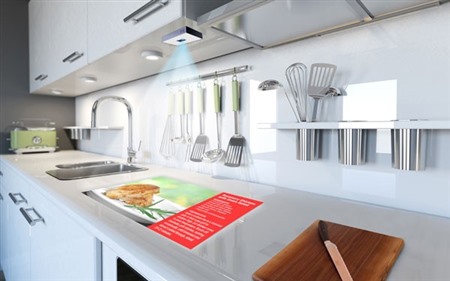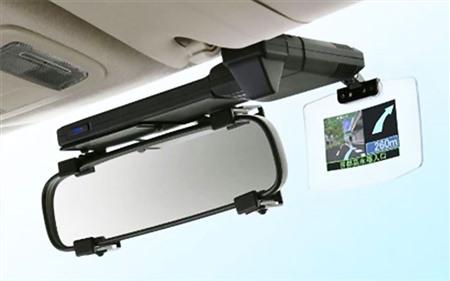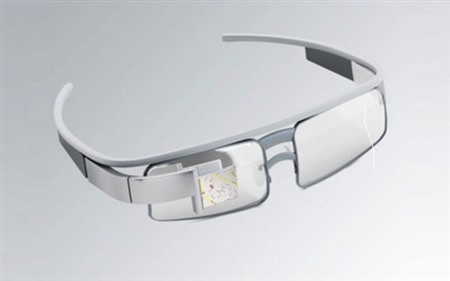SSZT889 November 2017
You put on your augmented reality (AR) headset and look up at the ceiling in your living room. At first, nothing looks out of the ordinary. Then a small piece of drywall seems to fall to the floor, followed by another, larger chunk. The 3D display in the headset makes it look convincing. Suddenly, the ceiling caves in and you are squinting into the bright, colorful sky of a fantasy world. Pterodactyls and unicorns soar overhead, yet you are still sitting on your couch, and you can still see your living room and the people around you. This is the type of experience that AR can enable.
Over the last few years, the buzz has gotten louder and louder in consumer technology: AR DLP® technology is an important tool for AR product developers because it enables three novel types of augmented experiences.
1. AR Projection.
 Figure 1 AR Projection in the Kitchen Displays a Recipe from a Cookbook
Figure 1 AR Projection in the Kitchen Displays a Recipe from a Cookbook-
Toys: A plain surface could become the high seas with pirate ships, or a forest where animals frolic. AR projection allows children to have physical toys interact with projected scenery and characters.
-
Smart kitchens: An electric stovetop with projected graphics and text can indicate the temperature of the surface and remaining cooking time, or maybe even a cooking video displayed on an unused part of the stove that syncs with the timing of the oven.
-
Casino gaming: Graphics and text projected directly onto playing surfaces such as table games and roulette wheels can attract players and make the experience more engaging. Read the white paper, “DLP Pico Technology for Gaming/Pachinko Applications.”
Learn more about DLP technology for display and projection and read the application note, “TI DLP® System Design: Brightness Requirements and Tradeoffs,” to determine how much brightness an AR projection concept requires. DLP technology’s high optical efficiency enables bright AR content with less power consumption, and its low latency enables the display to keep up with fast motion.
2. AR Head-up Display (HUD).
-
DLP automotive products: The first DLP chipsets engineered and qualified for automotive HUD applications are designed to be built into a vehicle and enable a large field of view.
-
DLP Pico products: DLP Pico chipsets enable the smallest, lowest-power DLP solutions. They are used in aftermarket HUDs to enable high-brightness/high-contrast displays in a small form factor like seen in Figure 2. For more information, read the application note, “TI DLP Pico Technology for Aftermarket Head-Up Displays.”
 Figure 2 AR HUDs Place Information Where Drivers Need It Most
Figure 2 AR HUDs Place Information Where Drivers Need It Most3. AR Wearable Displays.
- Gaming: Imagine soldiers marching across your living room, aliens bursting through the ceiling, or race cars driving on the coffee table. Combined with motion tracking, AR wearable displays can enable unique multiplayer gaming experiences, with characters and objects that interact with the real world.
-
Design: More productive applications of AR wearable displays are mechanical engineering and industrial design, in which the ability to see and manipulate 3-D graphics is valuable. This work is traditionally performed on 2D monitors, but an AR-wearable display can create a 3D image with the ability for multiple users to see different views of the same scene.
-
Sports: For motorcyclists, cyclists and skiers, looking at one’s phone while moving is impractical and dangerous. AR-wearable displays can present relevant information and notifications. For example, a cyclist may see their heart rate, calories burned and GPS directions, while a skier may see weather conditions and the position of friends on the mountain.
Learn more about DLP Pico technology for wearable displays and read the application report, “DLP Technology for Near Eye Display.”
 Figure 3 AR Wearable Displays Are Getting Smaller and Smaller
Figure 3 AR Wearable Displays Are Getting Smaller and SmallerAs AR products move from concepts and prototypes to real products, you’ll see even more creative ways to use DLP technology. No matter the AR application, DLP technology can enable high-brightness, high-contrast and low-latency AR display experiences.